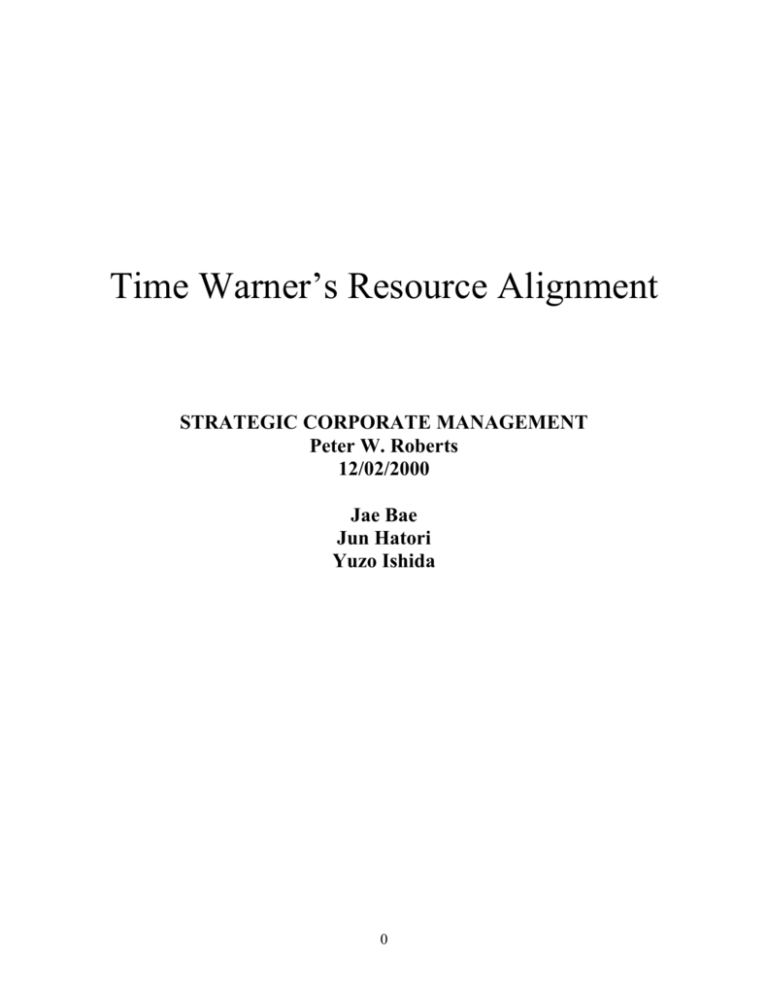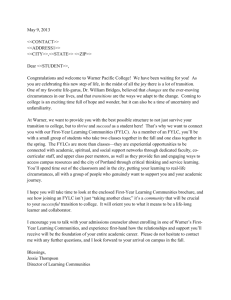Time Warner (CORPORATE STRATEGY)
advertisement

Time Warner’s Resource Alignment STRATEGIC CORPORATE MANAGEMENT Peter W. Roberts 12/02/2000 Jae Bae Jun Hatori Yuzo Ishida 0 EXECUTIVE SUMMARY Time Warner Inc. is positioned to be the dominant media, entertainment, and Internet company of the 21st century. Their overall strategy is to become the gatekeepers of the cable, television, and web communities and thereby control the distribution as well as the content of all media. On the one hand, they hope to leverage their huge size by creating synergies across all their various business units. On the other hand, building a complex horizontally diverse business combined with vertically integrated distribution channel are showing signs of serious strains. We propose in this analysis that Time Warner’s current strategy of aggressively merging with companies like AOL does not add significant value to the overall company. Our recommendation to streamline their businesses is based on the premise that creating strategic alliances rather than merging or acquiring diverse businesses may better enhance Time Warner’s corporate value. CORPORATE PROFILE Time Warner is composed of five diverse businesses: Cable Network, Publishing, Music, Filmed Entertainment, and Cable Systems. Although Time Warner is considered the industry leader in media content, its crown jewel is its cable network. In 1999, Time Warner generated 34% of its earnings (EBITA) from the Cable Systems division, more than any of it’s other units. Before the popularity of the Internet, Time Warner had hoped that it could build up an empire by owning premium content and delivering it via television and cable. However, with the emergence of the Internet, Time Warner felt threatened by the emergence of a different distribution channel, which had its own unique content format (web pages, mp3, mpg). In fact the leading ISP AOL had over 25 million subscribers compared to Time Warner’s 12.6 million cable home subscribers. Time Warner quickly realized that it could not holdback the Internet revolution that was saturating the world market and therefore agreed to merge with AOL in January of 2000. Cable Networks Turner Broadcasting - Atlanta Braves - Atlanta Hawks - WC Wrestling CNN News Group Home Box Office - HBO Publishing Books - Time Life Filmed Entertainment Music TW Music Group - Atlantic Recording - Warner Music Warner Brothers New Line Cinemas Magazines -Time - Sports Illustrated - Life There were many in the industry that praised the Time Warner and AOL’s merger claiming that the potential synergistic opportunities that could be generated from such a union could add great value to the combined company. However, there were others who claimed that the potential value generated from the amalgamation of all of the distinct 1 AOL: Internet Cable Systems Time Warner Cable TW Entertainment units would be less than the sum of the companies’ distinct parts. The major questions that need to be answered are: 1) What value can be generated before and after the merger? 2) Are all the Time Warner businesses aligned with their core competency and resources? 3) Would Time Warner’s different businesses be worth more if they were in the hands of specialized resource firms? SOURCE OF VALUE Pre-Merger On the surface, there exists some synergistic value within Time Warner’s 5 businesses. The ability to deliver a Warner Brother Movie through Time Warner’s Cable networks and the movie soundtrack distributed through its record labels does increase revenues for the overall firm. Another source of value is cross-selling products and services from one division to another by leveraging Time Warner’s large customer base. Time Warner may sell cable, CD, and movie services and products by tapping into its 200 million magazine subscribers. Post-Merger In addition to the value generated within Time Warner, a merger with AOL will provide Time Warner with additional premium distribution channels. For example Time Warner could possibly deliver its movies, music and information via the Web. Furthermore, Time Warner will be able to leverage itself by co-branding with a premier ISP. TROUBLE WITH CORPORATE STRATEGY Although there are many synergies generated from Time Warner’s five business divisions, there are signs that Time Warner has diversified itself too thinly across too vast an empire. For example, how does owning several professional athletic organizations, recording studios, and film companies fit into Time Warner’s core business of delivering content to customers via modern media technologies? Time Warner does not need to “own” the content in order to deliver the goods. Furthermore, running professional sport organizations does not seam to add much value to the company other than feed the egos of high-level executives. Secondly, there are signs that the synergistic opportunities may not warrant the accolades propounded by Time Warner. Terry McGuirk, who runs Turner’s entire network, once complained, “Of all the cable operators, Time Warner is my worst customer.” McGuirk made this reference because he had great difficulty getting programs such as CNNfn on some of his cable networks. As the organization gets larger, instances such as this may occur more frequently. Lastly, the old Time Warner as well as AOL Time Warner will restrict the company from freely competing in the market. A case in point is AOL Time Warner’s recent decision to allow a competing ISP provider EarthLink to provide its services on Time Warner’s cable lines in order to appease the government with non-monopolistic practices. Welcoming competition that may steal business from one’s own backyard would not have happened if AOL and Time Warner operated their businesses independently- free of all merger talks. 2 COMPETITORS The only firm that can come close in size to Time Warner is AT&T. AT&T has pursued a different corporate strategy by increasing the depth of its vertical diversification. In the last two years, it has acquired cable giant TCI and MediaOne to combine telephone and cable telephony. Compared to Timer Warner, they are less interested on developing content and more focused on the channels for all media delivery. In terms of resource alignment, AT&T does appear to be better positioned to succeed since the resources from all of its acquisitions fit more closely into one coherent entity. Nevertheless, the new AT&T is having trouble with its mergers since it now has to spend as much as $9 billion to upgrade its acquisition’s cable networks. The lesson to be learned from AT&T’s corporate strategy is that simply integrating vertical businesses does not spell success-as evidenced by the lack-luster performance of AT&T’s stock price in the past two years. ALTERNATIVES TO IMPROVE CORPORATE VALUE There are several strategies to increase corporate value: 1) Spin off Time Warner’s Cable business from the rest of its business in order to separate the content and delivery aspects of the business. 2) Time Warner could continue to aggressively acquire more content companies (like EMIalthough talks broke down recently) so that it can fully leverage on the cable and web distribution channels. 3) Get rid of the dogs and concentrate on leveraging its core business resources. RECOMMENDATIONS We did not think that pursuing the first alternatives is right for Time Warner since we believe that content is an important part of distribution. In other words, we think that consumers view the product and the distribution as a whole. Furthermore, we do not recommend the second alternative since Time Warner already has its hand full with integrating its recent acquisitions. Our recommendation is to pursue the middle of the path strategy of getting rid of some businesses while focusing on the more profitable division of Time Warner. For example, Time Warner should seriously consider divesting out of certain businesses in which their resources do not fit well with its core competencies-such as professional sports. Secondly, Time Warner should attempt to transfer the web and cable resources within the whole organization so that these forces could merge into the next generation of television-where all media can be unified. Lastly, Time Warner executives should seriously consider striking a careful balance of allowing the different business units to operate independently of one another and leveraging the resources from the different business units. It is obvious to cross sell one another’s products and services to a wider combined company customer base. However, making business decisions to appease government officials and channeling resources from one successful business unit to a weaker business unit do not make much economic sense. Instead, Time Warner should seek partnerships and alliances that complement their individual as well as the overall company’s resources. 3 RISKS AND CONTINGENCIES There are two major risks in operating a complex, multi-dimensionally diverse corporate organization: 1) Having the right motivation for cross-business cooperation 2) Following a unified and focused strategy. First, different business units may not be inclined to cooperate with one another because they may be functioning too independently of one another. In order to offset this problem, the full potential value of operating a horizontally diverse business should be realized by establishing the right incentives for different units to cooperate and leverage on each unit’s unique resources. Secondly, it may be difficult for top corporate executives to remain focused on a common corporate strategy. Furthermore, Time Warner may be prone to continue to make acquisitions based on product similarities rather than resource compatibility. Therefore, Time Warner should have as their mission statement: “To deliver quality media content across the next generation’s distribution channel.” BOTTOM LINE Time Warner will want to align its many resources to fit its core competency. Divesting out of some businesses, such as professional sports, makes sense since other specialized business owners could better manage these resources. Even the AOL merger should be viewed not in terms of product or distribution channel opportunities, but in light of resource transferability across all business units. Although it is tough to run a large organization that is growing in all directions, Time Warner will want to create unity and try to combine its new resources so that it can generate more value by amalgamating the different resources together as a whole rather than the sum of each individual part. 4







